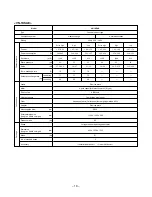
– 5 –
CAUTION
• If Heat Exchange Ventilators are not used for a long period of time, keep the exclusive circuit
breaker “OFF” for safety reasons.
If the power is left on, any build-up of dust could cause a heat generation or a fire.
• The system should never be used for any other purposes than intended such as for preservation of
foods, flora and fauna, precision devices or work of art.
• It could cause deterioration of foods or other problems.
• Install at a stable place of sufficient strength.
Please note that there might be some places not strong enough to install due the structure of building.
• Provide an exclusive circuit breaker that can completely break contacts on all the poles by more
than 3mm through direct connection to the power terminals.
Depending upon the environment for installation, it becomes necessary to install an earth leakage
breaker. Unless the earth leakage breaker is installed, it could cause an electric shock.
• Ask the sales office or the engineering shop to perform the work.
• Never fail to install the unit inside the heat insulting walls or, in other words, in the space insulated
from the open air.
If you install it outside or in the space equivalent to the open-air conditions, dew is condensed inside the
body in the winter season.
• The filter should be cleaned regularly.
Dust or dirt building-up on it can lead to a lack of oxygen in the room.
• Use gloves when cleaning the filter or heat exchange element.
Doing so will reduce any possibility of injury.
• It is strictly prohibited to place a container of combustible gas or liquid near Heat Exchange Ventila-
tors or to spray it directly with the gas or liquid.
It could cause a fire.
• Do not use outside the rated voltage.
It could cause a fire or an electric shock.
• Combustion apparatus should not be placed allowing a direct exposure to wind of Heat Exchange
Ventilators.
Incomplete combustion could occur on the apparatus.
• Don’t put a container of water on Heat Exchange Ventilators.
When water spills, it is likely to enter inside the unit and degrade electric insulation, possibly resulting in
an electric shock.
• Don’t incline Heat Exchange Ventilators when taking them out.
Otherwise, water remaining inside is likely to drop and wet the furniture or other property.
• Ask the sales office or the engineering shop to perform the work.
• Do not install in locations where harmful or corrosive gasses may be present (i.e. acidic, alkali,
organic solvent, paint gasses etc. from machinery or factories)
Installation in such a location could cause a gas-poisoning and a fire.
• Do not install in locations where oily smoke or soot may be present.
There is a possibility that oil will adhere to the filter, heat exchange element etc. and make operation impossible.
• Do not install in locations with high humidity, such as close to bathroom etc.
Installation in such a location could cause a breakdown.
• Don’t use benzene or metal brush when cleaning the filter and heat exchange element.
Otherwise, the unit will get unfit for use.
• Don’t blow directly against animals or plants.
Likely to cause bad effect on animals and plants.
• Do not wash Heat Exchange Ventilators with water.
It could cause an electric shock.
• Do not handle switches with a wet hand.
It could cause an electric shock.
Содержание VN-1KSAE
Страница 32: ......






































